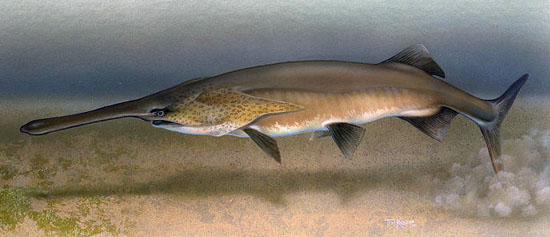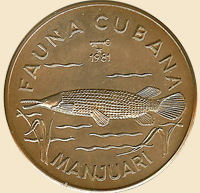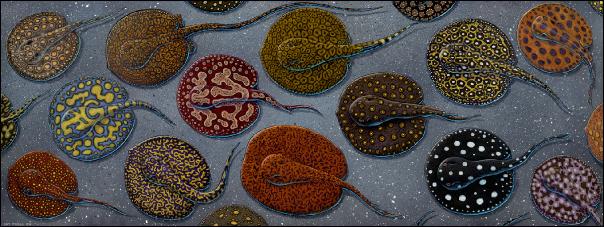Terrestrial zones
Fish diagrams •
MRI images •
Primitive vs. derived features •
Single fins •
Paired fins, etc. •
Hard parts: scales, teeth, skeleton •
Connecting inside-and-out •
Insides: internal organs •
_____________________________________
Dealing With Temperature
Hot and cold
For all its challenges, ocean temperatures are extremely consistent compared with land. Much of the deep sea never varies by even a degree outside of 2-5 ° (x (&neg; F). Surface water temperatures may vary from the tropics to the poles, but on a daily or seasonal basis, it doesn't vary as much as air temperature at the same latitude.
If you fall into very cold water in the Bering Sea, you will perish much more quickly than on an equally cold day on land. But whether fish or human, those who are well-adpated or equipped for life in the cold will survive. All is well as long as the temeprature doesn't change.
Because water has a high heat capacity, its temperature responds less to the addition and extraction of heat energy than rock or air. During the hot part of the day, air temperature may soar while a lake stays cool and refreshing. At night when the air and ground become cold, pool water seems warmer.
Like the sea, the daily temperatures in many terrestrial water bodies such as lakes and streams is much less than the surrounding ground or air. However some streams are so shallow that their temperature is affected by a day-to-night temperature cycle. Fishes that live in those streams must be able to tolerate that change. Juvenile Chinook Salmon may not tolerate temperatures higher than 75° for more than ..., while Desert Pupfish regularly deal with temperature swings betwee x to over ninety degrees F.
By developing the physiological and biochemical schemes necessary to inhabit more extreme and varied terrestrial niches, terrestrial fish have diversified into an amazing array of types that rival the marine species. The hundred of species of East African Cichlids that like in the Great Lakes along the rift zone are ...
Lack of water
The ocean never goes dry except at the edges affected by the tides. On land there are many streams and small bodies of water that go dry with the seasons. Fishes such as the Turquoise Killifish and Lungfishes have developed different strategies to cope with dehydration. The Killifish lives life in the fast land from birth, reproduction to death in less than a few months while the Lungfish "hibernates" for more than a year during dry times.
It gets so cold in many places that water isn't technically scarce, but it can freeze. ...
Observe the seasonal surface air temperature variation across the continental U.S. for a typical year.
Dealing With Freshwater
The bodies of most fishes aren't impervious to water. Fish absorb water from their surroundings through their skin and gill membranes. The semipermeable nature of the membranes in our bodies is critical to life processes. It allows the building blocks and wastes of cellular processesd to be passed into and out of each cell. The fluid and solvent nature of water allows it to circulate and transport chemicals where they are needed in our bodies.
The relationship between our skin and air is different than that between our skin and water. Most gases, including oxygen in the air, don't pass through skin into our blod stream as readily.
But fishes live in a solution of water that resembles the fluids in their bodies. The difference in concentration of dissolved substances within the fish vs. surrounding water causes pressure on water to flow one way or another - into or out of the fish. Unopposed, the continued gain or loss of water and related electrolyte imbalance would lead to death. Since fish can't count on Gatorade, nature has given them other ways to cope.
Fishes that live in freshwater tend to have less saline body fluids than their surroundings. There is pressure for water to move from the less saline side to the more saline side. Freshwater fish tend to gain significant amounts of water through their gills and the skin over their bodies. Scales help to retard this movement. So what's a fish to do?
Freshwater fishes drink little water and produce copious amounts of urine. The goldfish in your aquarium may be producing a third or its body weight as urine every day [3]. There is a problem with producing so much urine. Necessary as well as waste products are lost. By ingesting food and absorbing necessary salts in places such as the gills, fish actively take in enough to replace what's lost in urine.
Osmosis
For two different solutions of different salinities placed across a semipermeable wall or membrane, there is pressure for water to move to the side with the higher salt content. The greater the salinity difference between the two sides, the greater the pressure on water to move. That pressure is called osmotic pressure.
A solution of water is not pure H2O, but water that contains dissolved chemical components such as sodium and chloride. Dissolved components of seawater that are electrically charged, rather than neutral, are called ions. Single atoms or groups of atoms become charged by a gain or less of electrons that results in an unequal number of negative electrons relative to positive protons. While electrons are exchanged by atoms in every day chemical processes, the change never occurs due to a gain or loss of protons. You may see the dissolved sodium iion written down as Na+ to indicate it's +1 electrical charge.
Highlighted fish
American Paddlefish

Arapaima

Freshwater rays

Rreshwater rays Family ...
River rays or River Stingrays are unusual elasmobranchs because most sharks, rays and skates don't live in fresh water. Unlike their marine counterparts, River Rays have lost their ability to produce urea to combat loss of water.
Artist Ray Troll's vision of river stingrays in the Amazon.
Fossil freshwater ray Heliobatis radians

